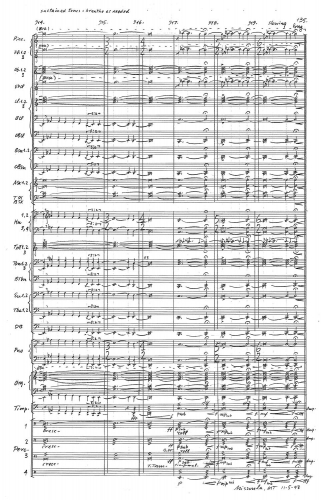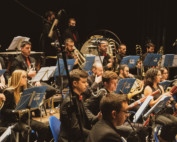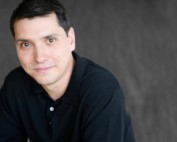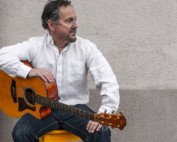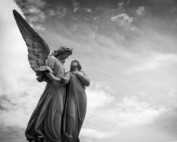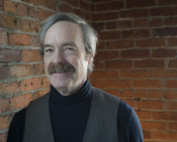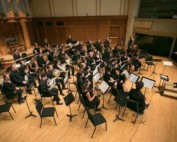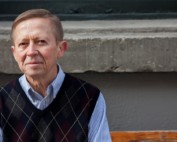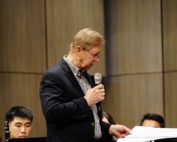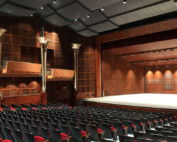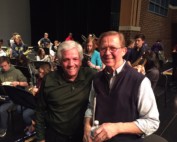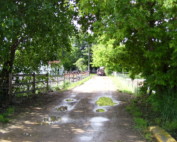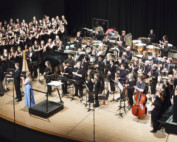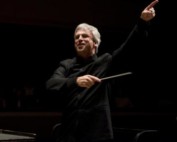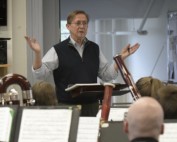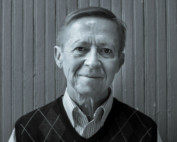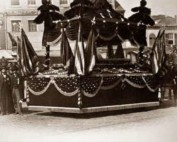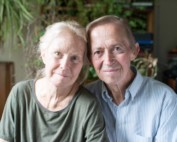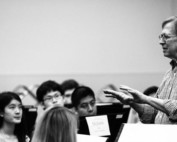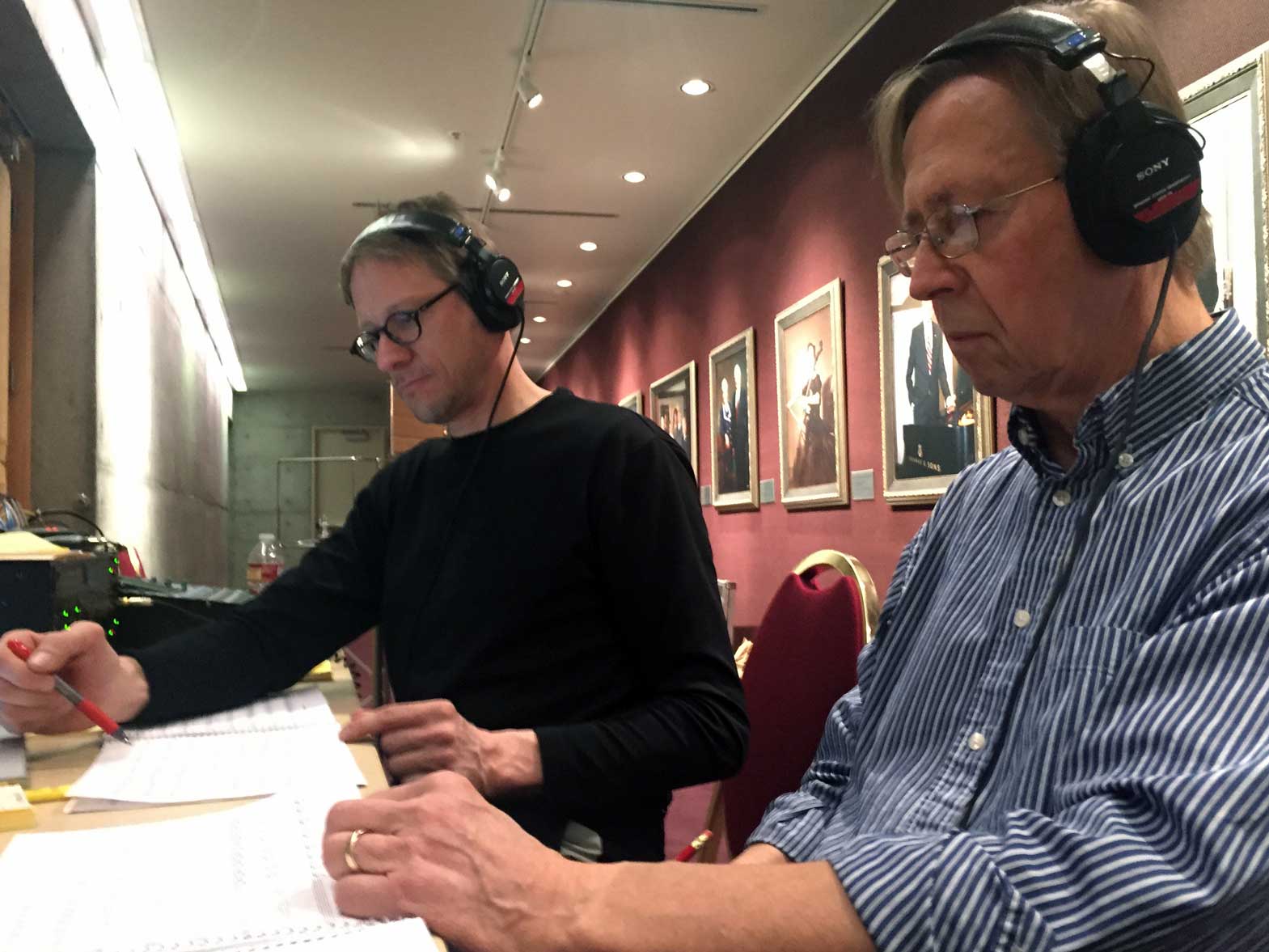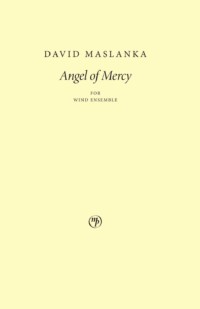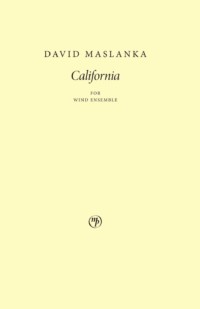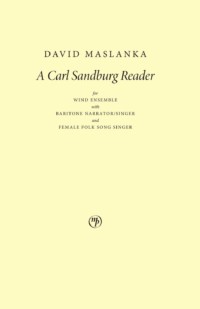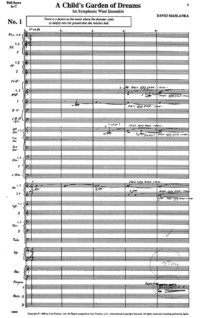Project Description
Wind Ensemble
1993
27 min.
Listen Now
Illinois State University Wind Symphony, Stephen K. Steele, cond.
On the album Maslanka: Piano Concertos, Testament, Traveler, Symphony No. 4
Illinois State University Wind Symphony, Stephen K. Steele, cond.
On the album David Maslanka: Wind Symphony
Dallas Wind Symphony, Jerry Junkin, cond.
On the album Garden of Dreams
Instrumentation
Picc Fl-3(3»AFl) Ob-3 EbCl BbCl-3 BCl CbCl Bsn-2 Cbsn ASx-2 TSx BSx | Hn-4 CTpt-3(1»BbPicc) Tbn-3 BTbn Euph-2 Tuba-2 DB | Hp Pno Org Timp Perc-4
- Piccolo
- Flute (3) (3rd dbl Alto Flute)
- Oboe (3)
- Clarinet in E♭
- Clarinet in B♭ (3)
- Bass Clarinet in B♭
- Contrabass Clarinet in B♭
- Bassoon (2)
- Contrabassoon
- Alto Saxophone (2)
- Tenor Saxophone
- Baritone Saxophone
- Horn in F (4)
- Trumpet in C (3) (1st dbl B♭ Piccolo Trumpet)
- Trombone (3)
- Bass Trombone
- Euphonium (2)
- Tuba (2)
- Harp
- Piano
- Organ (opt. Electric Organ)
- Timpani
- Required Percussion (4 players)
- Xylophone
- Glockenspiel
- Small Shaker
- Vibraphone
- Suspended Cymbal (1 v-sm., 1 sm., 3 lg.)
- Marimba (2)
- Crash Cymbals
- 5 Tom Set (3) (2 Bongos, sm. and med. toms, tenor drum)
- Chimes
- Wood Block (sm.)
- Bull Roar (lg.)
- Anvil
- Bass Drum (2)
- Crotales
- Gongs (5) (non-pitched, sm. to lg.)
- Tam-tam (2)
- Snare Drum (sm. and 2 med.)
Commissioned by
- The University of Texas at Austin Wind Ensemble, Jerry F Junkin, Conductor
- The Stephen F. Austin State University Band, Kevin L. Sedatole, Acting Director
- The Michigan State University Bands, John L. Whitwell, Director
and is dedicated to these conductors and ensembles with affection and gratitude.
Errata
These are errors in the score:
65 Piano should be 8vb.
88. Tenor Saxophone should have a bass clef.
131-2 Tbn 3 should be the same as Horn 1 down an octave.
139-140 Tuba should be down an octave.
339 Alto Saxes: add dotted half note (G/C) tied to 8th note (G/C) on beat 1 of 340
339 Alto Saxes: dim. hairpin to pp on beat 1 of 340.
406 DB beat 3 add ff
470 Contrabass Clarinet, DB: add tied over 8th note from 470.
487 Trumpet 2 should be tied from beat 2 to beat 3.
538 Percussion 1 (Vibraphone) should continue doubling Cl. 1.2.3.
615 Tpt 1,2 have same slur and accent as Ob. 1.2
638-9 Vibraphone: remove slurs
679-687 Vibraphone: Remove slurs; copy accents from Clarinet.
761 Beat 1 Clarinets should be F, not G (concert).
781 Bass Clarinet should have a bass clef.
781 Bsns. beat 3 should be F-A-F, not F-A-C.
807 Flutes don’t have staccato on beat 2. Those are erased notes.
823-828 Perc.1 accent should be the same as Fls., Obs., and Cls.
832-833 Alto Sax should double Eb Clarinet down an octave.
910 Euph beat 4 last note Eb/Bb, not C/G.
m914-916 Perc.3 is still on Tenor Drum (should be written on 2nd space)
Part Errata List (PDF)
Thanks to Yoshi Tsumura of the Osaka Shion Wind Orchestra for finding these items.
Program Note
The sources that give rise to a piece of music are many and deep. It is possible to describe the technical aspects of a work – its construction principles, its orchestration – but nearly impossible to write of its soul nature except through hints and suggestions.
The roots of Symphony No. 4 are many. The central driving force is the spontaneous rise of the impulse to shout for the joy of life. I feel it is the powerful voice of the Earth that comes to me from my adopted western Montana, and the high plains and mountains of central Idaho. My personal experience of the voice is one of being helpless and tom open by the power of the thing that wants to be expressed – the welling-up shout that cannot be denied. I am set aquiver and am forced to shout and sing. The response in the voice of the Earth is the answering shout of thanksgiving, and the shout of praise.
Out of this, the hymn tune Old Hundred, several other hymn tunes (the Bach chorales Only Trust in God to Guide You and Christ Who Makes Us Holy), and original melodies which are hymn-like in nature, form the backbone of Symphony No. 4.
To explain the presence of these hymns, at least in part, and to hint at the life of the Symphony, I must say something about my long-time fascination with Abraham Lincoln. From Carl Sandburg’s monumental Abraham Lincoln, I offer two quotes. The first is a description of Lincoln in death by his close friend David R. Locke:
“I saw him, or what was mortal of him, in his coffin. The face had an expression of absolute content, or relief, at throwing off a burden such as few men have been called on to bear – a burden which few men could have borne. I have seen the same expression on his living face only a few times, when after a great calamity he had come to great victory. It was the look of a worn man suddenly relieved. Wilkes Booth did Abraham Lincoln the greatest service man could possible do for him – he gave him peace.
The second, referring to the passage through the country from Washington D.C. to Springfield, illinois of the coffin bearing Lincoln’s body:
To the rotunda of Ohio’s capitol, on a mound of green moss dotted with white flowers, rested the coffin on April 28, while 8,000 persons passed by each hour from 9:30 in the morning till four in the afternoon. In the changing red-gold of a rolling prairie sunset, to the slow exultation of brasses rendering Old Hundred, and the muffled boom of minute guns, the coffin was carried out of the rotunda and taken to the funeral train.
For me, Lincoln’s life and death are as critical today as they were more than a century ago. He remains a model for this age. Lincoln maintained in his person the tremendous struggle of opposites raging in the country in his time. He was inwardly open to the boiling chaos, out of which he forged the framework of a new unifying idea. It wore him down and killed him, as it wore and killed the hundreds of thousands of soldiers in the civil war, as it has continued to wear and kill by the millions up to the present day. Confirmed in the world by Lincoln was the unshakable idea of the unity of the human race, and by extension the unity of all life, and by further extension, the unity of all life with all matter, with all energy, and with the silent and seemingly empty and unfathomable mystery of our origins.
Out of chaos and the fierce joining of opposite comes new life and hope. From this impulse I used Old Hundred, known as the Doxology – a hymn of praise to God; Praise God from Whom all Blessings Flow; Gloria in excelsis Deo – the mid-sixteenth century setting of Psalm 100. Psalm 100 reads in part:
1Make a joyful noise unto the Lord, all ye lands.
2Serve the Lord with gladness: come before his presence with singing.
4Enter into his gates with thanksgiving and into his courts with praise: be thankful unto him, and bless his name.
I have used Christian Symbols because they are my cultural heritage, but I have tried to move through them to a depth of universal humanness, to an awareness that is not defined by religious label. My impulse through this music is to speak to the fundamental human issues of transformation and re-birth in this chaotic time.
Further Reading
Maslanka Weekly: Best of the Web – No. 122, New Performances of Popular Symphonies
Maslanka Weekly highlights excellent performances of David Maslanka’s music from around the web. This week, we are excited to feature amazing new performances of three of David's most popular symphonies: Symphony No. 4, Symphony No. 7, and Symphony No. 8.
Maslanka Weekly: Best of the Web – No. 116, Recent Performances of Symphony No. 4
Maslanka Weekly highlights excellent performances of David Maslanka’s music from around the web. This week, we showcase three recent extraordinary performances of Symphony No. 4.
Interview with Tiffany Woods (2003)
In May 2003, Tiffany Woods emailed David a series of questions in the course of writing a paper. She was a student at the University of North Carolina Greensboro and taking a Band Literature course [...]
From the Maslanka Archive – No. 35, Damon Talley’s Interview of David
From the Maslanka Archive features media and stories of David's life and work. This week, we are excited to feature one of David's very last interviews. In April of 2017, Damon Talley - Director of Bands at LSU - had the opportunity to sit down with David and discuss Symphony No. 4 during a residency with the LSU Wind Ensemble.
From the Maslanka Archive – No. 33, John Floridis’s Interview of David
From the Maslanka Archive features media and stories of David's life and work. This week, we are excited to feature an episode from Montana Public Radio's Musician's Spotlight featuring John Floridis interviewing David about his music and background as a composer.
Maslanka Weekly: Best of the Web – No. 112, Angels
Maslanka Weekly highlights excellent performances of David Maslanka’s music from around the web. This week, we are excited to feature three of David's works that make either direct or indirect reference to angels: Symphony No. 4, My Lady White, and Angel of Mercy.
From the Maslanka Archive – No. 32, Julian Velasco’s Interview of David – Part 2
From the Maslanka Archive features media and stories of David's life and work. This week, we are excited to feature Part 2 of Julian Velasco's interview of David from his home in Missoula, MT in 2016.
From the Maslanka Archive – No. 31, Julian Velasco’s Interview of David – Part 1
From the Maslanka Archive features media and stories of David's life and work. This week, we are excited to feature Part 1 of Julian Velasco's interview of David from his home in Missoula, MT in 2016.
From the Maslanka Archive – No. 30, Jim Tevenan’s Interview of David
From the Maslanka Archive features media and stories of David's life and work. This week, we are excited to feature an episode from Spokane Public Radio's From The Studio featuring Jim Tevenan interviewing David about his music. The Whitworth Wind Symphony had just performed David's Symphony No. 4.
Maslanka Weekly: Best of the Web – No. 109, Lawrence University Conservatory of Music
Maslanka Weekly highlights excellent performances of David Maslanka’s music from around the web. This week, we feature three ensembles from Lawrence University Conservatory of Music in performances of David's music: Symphony No. 4, Crown of Thorns, and Tears.
Maslanka Weekly: Best of the Web – No. 108, Keitaro Harada
Maslanka Weekly highlights excellent performances of David Maslanka’s music from around the web. This week, we feature Keitaro Harada's interviews of Scott Hagan and Kevin Michael Holzman on David's Symphony No. 10 and Symphony No. 4.
From the Maslanka Archive – No. 28, David in Rehearsal with Mike Fansler and the WIU Wind Ensemble
From the Maslanka Archive features media and stories of David's life and work. This week, we are excited to feature a video of David in rehearsal with Mike Fansler and the Western Illinois University Wind Ensemble from December 2011. The rehearsal footage captures an amazing realization of the "Doxology" from Symphony No. 4.
From the Maslanka Archive – No. 21, David’s Final Public Address
From the Maslanka Archive features media and stories of David's life and work. This week, we are excited to feature David's last known public address which was given at The Hartt School at the University of Hartford on May 6, 2017.
Maslanka Weekly: Best of the Web – No. 98, New and Classic Recordings of David’s Symphonies
Maslanka Weekly highlights excellent performances of David Maslanka’s music from around the web. This week, we feature two new performances of favorite symphonies: Symphony No. 4, Symphony No. 7, and the recording of the premiere performance of "Allegro Molto" from Symphony No. 2.
Maslanka Weekly: Best of the Web – No. 86, Gary Green
Maslanka Weekly highlights excellent performances of David Maslanka’s music from around the web. This week, we feature three of David’s compositions that Gary Green championed: Symphony No. 8, Symphony No. 4, and Symphony No. 3.
From the Maslanka Archive – No. 4, Stephen & Andrea Steele Visit David & Alison in Missoula (2008)
From the Maslanka Archive features media and stories of David's life and work. This week, we are excited to feature pictures from the outside of David's residence in Missoula, Montana taken during a visit by Stephen & Andrea Steele in 2008.
Maslanka Weekly: Best of the Web – No. 77, Symphony No. 4 (2019)
Maslanka Weekly highlights excellent performances of David Maslanka’s music from around the web. This week, we showcase five extraordinary performances of Symphony No. 4 from 2019.
Maslanka Weekly: Best of the Web – No. 64, More Recent Maslanka CD Releases
Maslanka Weekly highlights excellent performances of David Maslanka’s music from around the web. This week, we feature three new recordings of favorite works: Mass, Remember Me, and Symphony No. 4. (Photo by Zachary C. Person)
Maslanka Weekly: Best of the Web – No. 63, Malcolm W. Rowell, Jr.
Maslanka Weekly highlights excellent performances of David Maslanka’s music from around the web. This week, we feature three of David’s compositions that Malcolm W. Rowell, Jr. and the University of Massachusetts-Amherst Wind Ensemble championed: A Child's Garden of Dreams, Symphony No. 4, and Tears.
Maslanka Weekly: Best of the Web – No. 34, Symphony No. 4 Rehearsal with Jerry Junkin
Maslanka Weekly highlights excellent performances of David Maslanka’s music from around the web. This week, we feature a spectacular livestream rehearsal featuring Jerry Junkin working with the Vandegrift High School Wind Ensemble in David's epic Symphony No. 4.
Maslanka Weekly: Best of the Web – No. 30, David’s Wisdom
Maslanka Weekly highlights excellent performances of David Maslanka’s music from around the web. This week, we take a special look at David's philosophies on music, the creative process, and creating peace through musical tones.
Maslanka Weekly: Best of the Web – No. 29, Remembering David
Maslanka Weekly highlights excellent performances of David Maslanka’s music from around the web. We start the beginning of 2019 by taking time to remember the life and music of David Maslanka.
Maslanka Weekly: Best of the Web – No. 25, Symphony No. 4 (2018)
Maslanka Weekly highlights excellent performances of David Maslanka’s music from around the web. This week, we feature five of the most extraordinary performances of Symphony No. 4 from 2018.
Maslanka Weekly: Best of the Web – No. 7, Tribute
Maslanka Weekly highlights excellent performances of David Maslanka’s music from around the web. This week, we remember the life of David Maslanka and Alison Matthews with unforgettable performances of Symphony No. 4, "Song for Alison" from Song Book for Alto Saxophone and Marimba, and Symphony No. 10: The River of Time.
David Maslanka: Works for Younger Wind Ensembles
Here are more than twenty works for wind ensemble, arranged in approximate ascending order of difficulty, with commentary by David Maslanka
Recording the Wind Ensemble Music of David Maslanka
Mark Morette of Mark Custom Recording shares his extensive experience in recording wind ensembles.
David Maslanka and the Natural World: Three Studies of Music for Wind Ensemble
Kate Sutton's Master's thesis is a study on David's Third, Fourth, and Ninth Symphonies with special emphasis on their themes on nature. She explores the influence that moving to Missoula, Montana had on David for Symphony [...]
David Maslanka’s Symphony No. 4: A Conductor’s Analysis with Performance Considerations
Dr. Stephen Bolstad's dissertation on David's Symphony No. 4 gives a thorough analysis and helpful advice to conductors. The author also includes a brief biographical sketch and provides insight into David's unique compositional approach to [...]
Dangerous Times
Remarks given on 29 March 1994 at Michigan State University before a performance of Symphony No. 4 It goes without saying that we live in dangerous times, and that the human family is threatened by [...]
